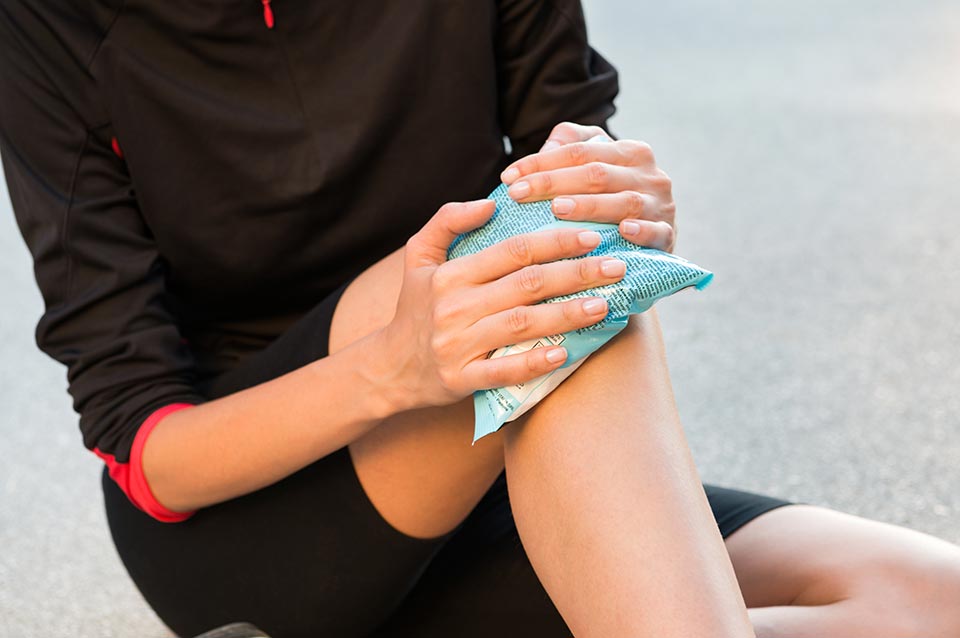RICE VS POLICE
Is the R.I.C.E. method still the best way to initially treat an acute joint injury? Or is it time to adopt the P.O.L.I.C.E. method? First, let's define the two methods.

R.I.C.E.
Anyone who has sustained an injury ranging from an ankle sprain to something more serious such as surgery has heard about how to handle the acute pain and symptoms one experiences. Rest, ice, compression, and elevation (R.I.C.E.) has been recommended for any of these individuals. However, patients can take the "rest" portion of RICE too literally and stay in bed or on the couch while limiting any movement whatsoever of their site of injury. Also, it's vital that compression is promoted as much as ice and elevation since it is the compressive factor of R.I.C.E. that helps significantly with any post-injury swelling. R.I.C.E. has been a staple in the management of acute injuries for decades but, as research has deepened, R.I.C.E. has had to evolve to match the constantly evolving field of medicine.
P.O.L.I.C.E.
Evidence based practice has driven the healthcare community to promote a new way of managing acute injuries via: protect, optimal loading, ice, compression, and elevation. This is otherwise known as the acronym P.O.L.I.C.E. While the ice, compression, and elevation portions are the same between these two phrases, protection and optimal loading are crucial differences between these two acute injury management methods.
PROTECTION
Protecting an injured area will vary dependent on the involved tissue, the severity, and the location of the injured area. Sometime this may require some short-term immobilization depending on the site and severity of one's injury such as a grade III ankle sprain. However, unless directed by your primary physician or surgeon, you should still be able to move an injured area within limited ranges to promote blood flow and circulation in order to reduce excessive stiffness/scar tissue accumulation. Over protecting an injured joint can be as detrimental to the rehabilitation process as under protecting. A physical therapist is educated and trained into handling these and more musculoskeletal injuries and conditions and can safely prescribe a home exercise program that promotes mobility while protecting the injured site.
OPTIMAL LOADING
Optimal loading is another key and significant difference between R.I.C.E. and P.O.L.I.C.E. Fear and anxiety with stressing the tissue of an injured site is a completely normal response following an acute event, especially if it is the first time you have injured yourself. For instance, it may hurt to put any weight whatsoever through your ankle if you sprain it which leads to fear of damaging the joint. However, evidence shows that we should encourage the use of the affected tissue as much as we are able to. This will allow us to preserve the tissues function without violating the Protection principle of P.O.L.I.C.E. By optimally loading the tissue, you neuromodulate the sensitive and protective pain receptors that are distributed throughout your entire body. Your physical therapist should be able to strengthen the soft tissue and joint just enough to reduce the likelihood of reinjuring that same area in the future.
How to successfully use P.O.L.I.C.E.?
By adopting P.O.L.I.C.E. into acute injury management, this will improve your rehab prognosis and reduce the amount of time it takes for you to get back to normal levels of functioning. Implementing P.O.L.I.C.E. successfully is something that involves utilizing the subject matter experts into the acute phase of injury management as early as possible. Physical therapists, orthopedic surgeons, and orthopedic PA-Cs are all qualified to guide the management of acute injuries. The earlier a patient can get into the office the quicker the rehabilitation process will be, and the faster their symptoms will be resolved. The providers and therapists at CAO are available to get you on the road to recovery when an injury occurs. Schedule an appointment with provider and location near you today.

